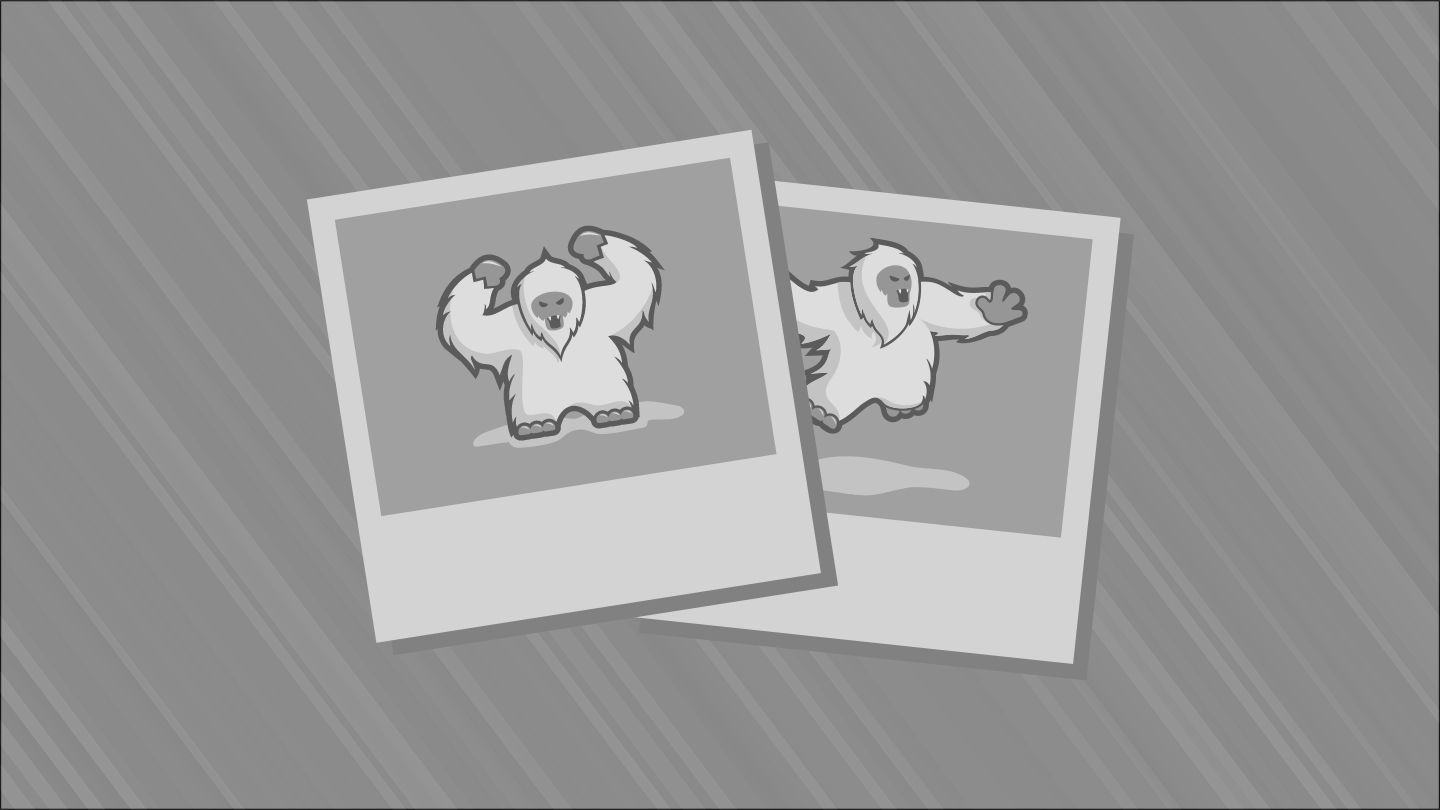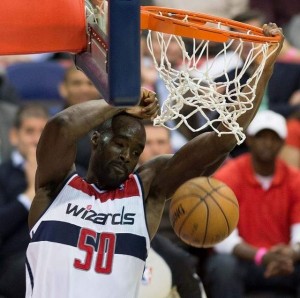 At this very moment, the fate of the Western Conference might be hanging in the balance of the Phoenix Suns’ front office.
At this very moment, the fate of the Western Conference might be hanging in the balance of the Phoenix Suns’ front office.
Let me explain.
Let’s start out with a simple question:
Does anyone still take the Clippers seriously as Western Conference favorites? We’ve seen this act before: Chris Paul and Lob City put up highlights every night and make fans drool over the thought of a potential star-studded Heat-Clippers Final.
When the playoffs eventually come around, however, the Clippers recede back to looking like the fourth- or fifth best team in a loaded Western Conference. Sure, they pushed the Grizzlies to seven games last year. However, if you think DeAndre Jordan and Blake Griffin can effectively defend top-ranked opponents for an entire postseason, I’d like to invite you to play a quick game of “Name That Big Man.”
Player A has played 18 games and has defended 6.2 shots at the rim per 33.4 minutes a game, allowing 49.1% to go in.
Player B has played 19 games and has defended 8.2 shots at the rim per 35.4 minutes a game, allowing 59% to go in
Player C has played in 19 games and has defended 6.1 shots at the rim per 37.2 minutes a game, allowing 52.6% to go in.
I’ve got bad news for Clippers fans; two of three these guys are Blake Griffin and DeAndre Jordan. The third is David Lee, who is considered by some to be the worst interior defender in the NBA. Here’s the kicker: Lee is actually Player A and Jordan and Griffin are Players B and C, respectively. Comparatively speaking, DeAndre Jordan is making David Lee look like Roy Hibbert. 
Opponents have attempted 14.3 shots at the rim against Jordan and Griffin per game and have scored on well over half of those attempts. That equates to more than thirty points a game on easy shots in the paint against only those two players. Note: this total doesn’t even begin to consider the added points that come from fouls. By the way, Griffin and Jordan collectively commit 7.1 fouls per game. (Exactly 2.5 more per game than the Spurs’ big man trio of Tim Duncan, Tiago Splitter and Boris Diaw.)
Part of the problem for the Clippers is that neither Jordan nor Griffin plays particularly tough interior defense. As you may recall, Chauncey Billups called Griffin soft after two years of playing together.
Just look at these two plays from the first half of Wednesday’s loss to the Hawks to see why L.A. gives up so many points in the paint.
1. Al Horford overwhelms DeAndre Jordan
2. Al Horford overwhelms Blake Griffin
When Jordan and Griffin get beaten up down low, they invariably get lazy and start hacking — sending them into early foul trouble with consistency. When the fouls toll up and Doc Rivers is forced to sit them, they get replaced by two of the league’s least effective 7-footers.
For my money, Byron Mullens is the worst interior defender in the NBA. For starters, he owns the worst Defensive Rating for any center in the league. Per 100 possessions, L.A. has been outscoring opponents by five points on the season. However, when Mullens is in the lineup, the Clippers have been abysmal, getting outscored by 16 points per 100 possessions. Mullens has a very rudimentary understanding of where he should place himself on the court and when to help out on defense, resulting in embarrassing defensive breakdowns like this:
While some have referred to Mullens and his partner-in-crime Ryan Hollins as the Clippers’ offense-defense 7-footer platoon, it’s a very crude designation to make. It is true that Hollins is better than Mullens on defense. Regardless, he’s still well below a league-average defender as well. He’s compiled an astounding 7.3 fouls per 36 minutes so far this season, by far the most for any player with over 150 minutes of logged action.
Hollins is also one of the league’s worst rebounders for a 7-footer, averaging fewer than seven rebounds per 36 minutes. This puts him right on par with some of the league’s better rebounding guards (Evan Turner, Lance Stephenson) but well below most competent centers.
Jordan. Griffin. Mullens. Hollins.
That’s it. That’s the extent of the Clippers’ interior depth. I mean, if you were so inclined, I guess you could include 37-year-old Antawn Jamison. But he’s only appeared in seven games this season and is undersized for a big man as is.
Rumors have been swirling that Lamar Odom might return to the team as a free agent in January. I’m skeptical Odom would be worth the investment. He’s an inherent distraction for the locker room and is an old 34 years of age. While he became a somewhat effective interior defender in recent years, he’s also coming off a tumultuous summer of alleged drug use, which has him looking more like the skinny Odom of the early-2000s than the bulky Odom from last year (that’s not a good thing.)
The Clippers’ pick-and-roll defense ranks 29th in the league, allowing 1.17 points per game, per Robby Kalland via Synergy Sports. This is a result of everything I’ve spelled out; Jordan and Griffin are below average rim protectors and Mullens and Hollins are the league’s least effective backup interior defenders. Not to mention, outside of Matt Barnes and the possible exceptions of Chris Paul and Jared Dudley, every player on the roster is better known for their offense than defense.
So, let’s go back to Phoenix, where I mentioned the Suns could change the balance of power in the Western Conference. How so, you ask?
Through one simple move.
As you might remember, Emeka Okafor was traded to Phoenix in October as a part of the Marcin Gortat trade. Okafor has been sidelined all season with a herniated disc in his neck and likely will not return to the court until January at the very earliest. He’s also in the final year of a six-year, $72 million deal and is currently making about $15 million this season. One thing is certain: he has no future with the Suns. They already have two promising young centers in Miles Plumlee and 20-year-old Alex Len.

The Suns’ front office, meanwhile, is extremely tactful. They’ve saved millions of dollars and have picked up several assets in trades with the Pacers and Wizards since the start of the summer. If Okafor gets healthy and starts itching for a chance to play in a playoffs, as I suspect he will, the Suns will likely pounce on the opportunity to save even more money through negotiating a buy-out.
Now, of course, the Suns themselves are in the playoff race so it might be too soon to guarantee that a healthy Okafor will be bought out. There’s still a small chance his expiring deal could get traded again. Or, perhaps he will stay on and vocally lead Phoenix during the playoff stretch. More likely though, Phoenix will be negotiating a buyout with Okafor’s as soon as he gets healthy enough to play.
Consider this: Los Angeles can’t trade its first-round pick this year under the NBA’s Ted Stepien rule because they already owe next year’s pick to Boston. They’re also fully capped out on contracts and lack the expendable salaries necessary to swing a trade for a veteran defensive presence (a la Elton Brand or Zaza Pachulia). To put it kindly, their only expendable asset is Reggie Bullock, who’s not overwhelmingly valuable to begin with.
That leaves the Clippers with three options. They can stick it out with the rotation they have and hope to sign a healthy Odom by January; they can search the free agent scraps for slim pickings (Earl Barron, anyone?); or they can undersell Bullock, Willie Green and a distant future first-rounder for a backup big making under $5 million.
To me, none of those options sound too great.
This is where the Suns’ decision with Okafor becomes so important for the Clippers.
If Emeka is healthy & Suns are still in playoff hunt, he will add wins.
If Emeka is healthy & Suns are out of playoff, Suns can trade him to contender for younger pieces & picks.
If Emeka remains injured, Suns can flip his $14.5m expiring contract to non-contending over-cap teams (lots of them like NYK, LAL, BKN, CHI) in exchange for star, younger pieces or picks.
Emeka+Suns picks can also be used to match salaries in a trade for disgruntled star – e.g. Kevin Love.
Suns have arguably the smartest GM in the NBA (Dudley-for-Bledsoe & Scola-for-Green/Miles/pick are 2 of top 5 deals so far this season, both going Suns’ way). Won’t be dumb enough to buy-out Emeka when he commands more value as large expiring contract.
Last I heard the suns are not in the charity business. If the guy has this much value they will not let him go to a rival for nothing… Either trade him for more assets or let him walk after this season, either way he comes off the books after this year, no need to GIVE him to your division rivals… smh at this piece or writing.
Why the hell would the Suns buy-out Emeka if his contract expires this season? Trade or nothing.